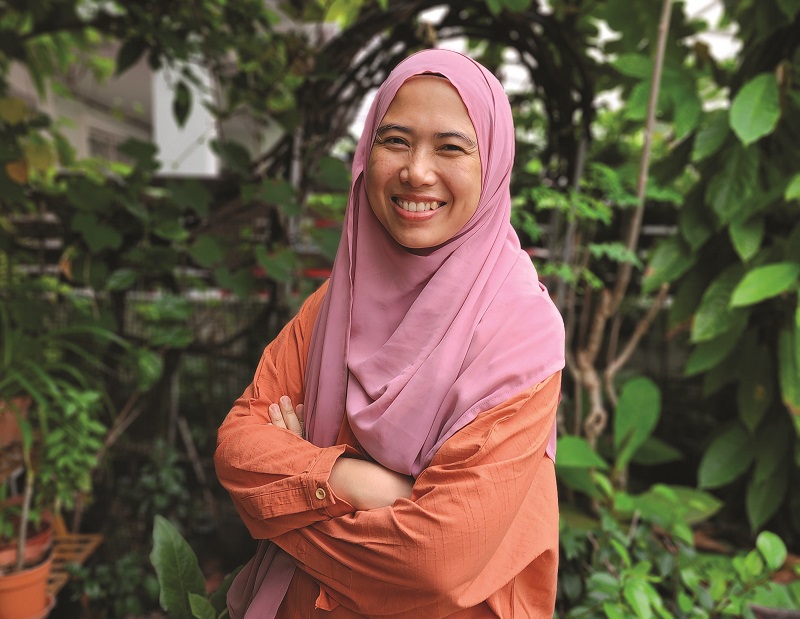
The process of producing watercolours involves extensive experimentation until the desired colour and texture are achieved (All photos: Aidafiqs Handmade)
What could possibly encourage a trained chemical engineer to jump into the world of arts and entrepreneurship? Aida Zulkifli, a proud mother of three, made the pivotal decision to leave her highly regarded profession many years ago to pursue an even more fulfilling job — homeschooling her children.
Motherhood inevitably changes a person, one way or another. The founder of Aidafiqs Handmade — a portmanteau of Aida and her husband’s name, Taufiq — says she became interested in learning a new skill with every pregnancy.
“When I had my first child, I learnt to sew. Second child, I picked up knitting as she was born in London during winter. When I was carrying my third, I became conscious of the toiletries we were using. I made it my mission to stop buying personal care products such as bath soaps, shampoo and lotion,” she explains.
Living by the belief of “anything we can make, we try to make”, one of her children posed a question that inspired Aida to start selling watercolours. “The nature of our homeschooling is we like to create everything from scratch. One day, my daughter asked, ‘Why are you buying watercolours? Why don’t you make them?’”
A deeper look at the local stationery market led Aida to notice a gap she could fill — a lack of handmade watercolour paints. This sparked an interest in commercialising her creations. To advertise the paints, she utilised Aidafiqs Handmade Instagram early last year, which she had used previously to sell bar soaps. “People were actually keen to buy the products.”
image0.jpeg

The process of producing watercolours involves extensive experimentation until the desired colour and texture are achieved. Luckily for Aida, making soaps for her family in the last decade provided her with the artisanal skills to process paint. “Soap-making is like actual chemistry work that requires you to have the whole PPE (personal protective equipment) on. So, I found watercolour-making a piece of cake lah.”
Although watercolours are not as hard to prepare as soaps, it still entails considerable time and effort to create one shade. “One colour takes me at least an hour of mulling the pigment to get a smooth texture. I make it in small batches. For one colour, I can get between 10 and 20 half pans — a half pan contains 2ml of paint.”
The paint maker uses tools such as a glass plate and glass muller to mix the pigment with the binder such as madu tualang or gum Arabic. The ingredients are mulled together until a smooth paste is formed. The mixture is then poured into painstakingly made batik pans, an alternative to plastic containers used for factory-manufactured paint.
Aida subscribes to zero-waste principles and rejects the use of plastics in her daily life. When she wanted to start the enterprise, she was concerned about the packaging of the paints. “When running a business, I would have to make product purchases in bulk, which meant I would produce a lot of plastic. I didn’t want that.”
She overcame the challenge by creating her own version of environmentally friendly pans, available in two sizes — half and full — which are made using batik fabric from Terengganu. The batik is waxed using locally sourced raw beeswax to ensure it is water-resistant and hard-wearing.
“The material will become a bit sticky after it is waxed. That’s when I fold it into the shape of a half or full pan. Since it is waterproof, there’s no problem putting the paint in it.”
Delivery was another issue for Aidafiqs Handmade. “Early on, I used paper envelopes but the interior was lined with bubble wrap, so there was still plastic.” As the business grew, Aida adapted the concept of her batik pans to make batik holders to house a collection of paint before delivering them to customers. Shredded paper from her children’s printing materials for homeschooling, cardboard and some wrapping paper are also used to make sure the product packaging is sustainable.
The founder is especially thankful for the presence of e-commerce platform Shopee because she does not need to worry about building a website for Aidafiqs Handmade. All six collections of paints can be purchased on the platform.
Besides her Primary, Secondary, Floral and Nature collections, Aida also makes gouache — an opaque paint; unlike watercolour, which is transparent — for the Pastel and Teatime collections. Other products are artist rolls (stationery and art tools organiser) and wooden palettes.
Aida creates paint shades depending on what she wants to use, instead of making them just for the sake of producing something. To date, she has made more than 30 colours. As she likes to paint nature, she is planning to come up with a soil collection, with shades inspired by the organic material. “Soil is fascinating because it has different colours and you can spot the variety at our limestone hills,” she observes.
Commercially made paints are infused with fillers or stabilisers. “Ours is very pigmented because we don’t use fillers. I have a customer who uses watercolour every day. She bought our dot card, which is a piece of paper containing dots of colours on it, much like a sample. She always takes the travel-friendly kit with her as she sketches everywhere she goes [but] still hasn’t run out of it although she paints a lot. It has been a year since she got it.”
Aida is not an artist with a professional certificate, but a delightful paint maker who thoroughly enjoys arts and crafts. She is thrilled by the idea of being able to fulfil the needs of artists who prefer handmade watercolours instead of tubes of paint from art supply stores.
This article first appeared on July 11. 2022 in The Edge Malaysia.


